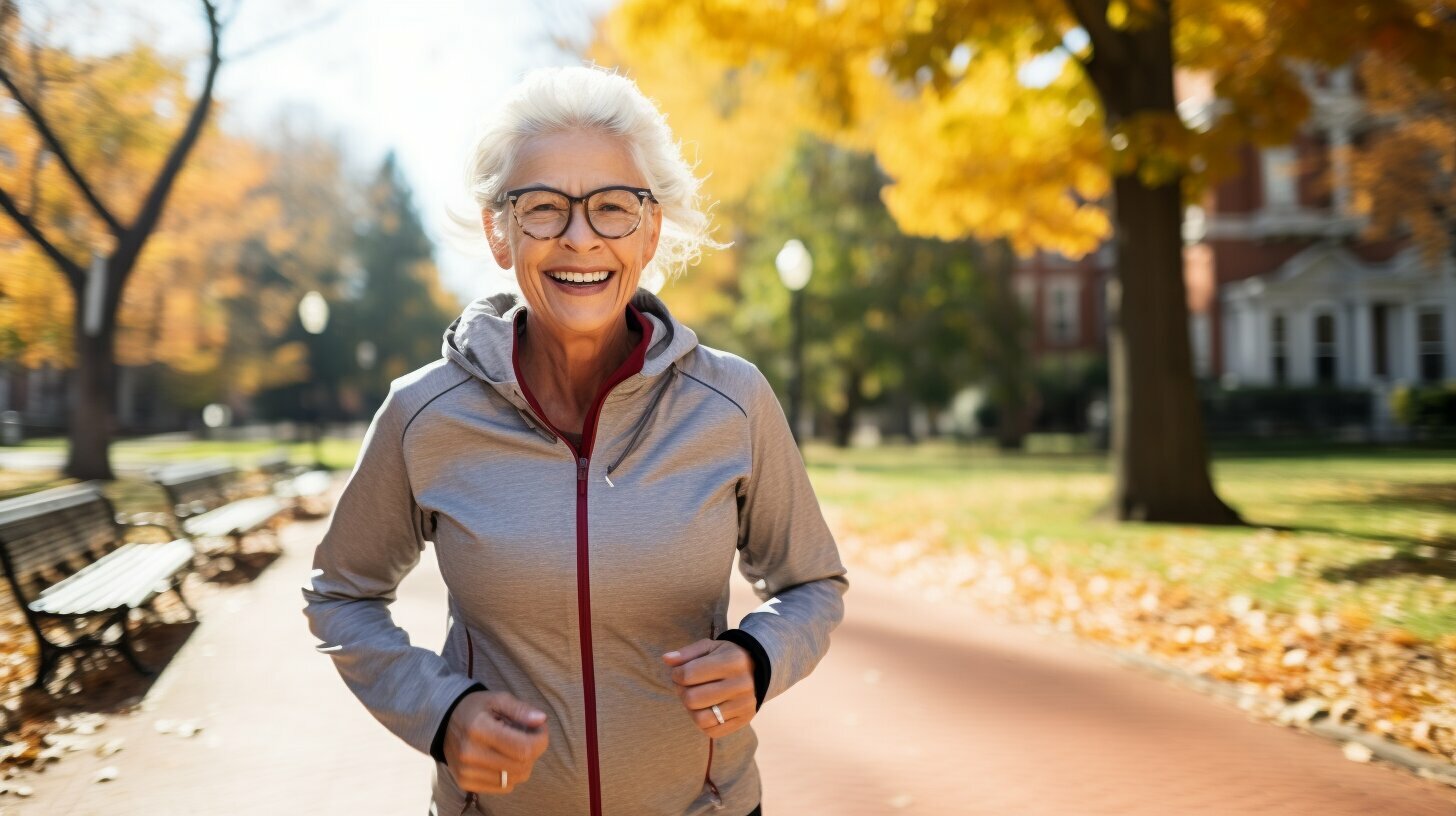As we age, it’s important to prioritize our health and fitness, and low-impact cardio workouts offer an ideal solution for seniors looking to stay active. These workouts provide numerous health benefits while being gentle on the body, making them accessible for individuals of all fitness levels.
Whether you’re a beginner or dealing with chronic conditions like osteoarthritis or osteoporosis, low-impact cardio exercises can help improve your overall well-being.
In this article, we will explore a variety of low-impact workouts specifically designed for seniors, highlighting the benefits they provide and offering guidance on how to incorporate them into your fitness routine.
- Low-impact cardio workouts are beneficial for seniors, providing health benefits while minimizing strain on the body.
- Swimming, walking, yoga, sitting exercises, and strengthening exercises are excellent options for low-impact cardio workouts.
- These exercises improve flexibility, strength, balance, and overall cardiovascular function.
- Low-impact workouts are suitable for beginners and individuals with chronic conditions like osteoarthritis or osteoporosis.
- Prioritizing consistency and setting realistic goals are key elements of creating a healthy fitness routine.
The Benefits of Low-Impact Cardio Workouts
Engaging in low-impact cardio workouts brings a myriad of benefits to seniors, from enhancing cardiovascular health to promoting joint healing and reducing the risk of injuries. These exercises are designed to be gentle on the body while still providing effective results. Whether you’re a beginner or dealing with chronic conditions, low-impact cardio activities can be tailored to suit your needs and fitness level.
One of the key advantages of low-impact exercises is their ability to reduce the risk of heart disease. Regular cardio workouts, such as swimming, walking, or cycling, help improve heart health by strengthening the heart muscle and improving overall circulation. These activities can also lower blood pressure and cholesterol levels, reducing the risk of cardiovascular complications.
Another significant benefit of low-impact workouts is their positive impact on joint health. High-impact exercises can put excessive strain on joints, leading to pain and injury, especially for seniors. Low-impact activities like swimming and yoga provide a gentle way to increase flexibility, strengthen muscles, and improve joint mobility. They also aid in the healing and recovery of damaged joints, making them ideal for seniors with arthritis or other joint-related conditions.
“Low-impact cardio exercises are not only suitable for seniors; they can also be effective for individuals of all ages and fitness levels.”
In addition to cardiovascular health and joint healing, low-impact cardio workouts offer a well-rounded approach to overall well-being.
These exercises help improve balance, coordination, and mental well-being. For example, yoga combines low-impact movements with deep breathing and relaxation techniques, promoting mindfulness and reducing stress levels. It also enhances strength, flexibility, and balance, all of which are essential for maintaining independence and preventing falls.
| Benefits of Low-Impact Cardio Workouts: |
|---|
| Enhances cardiovascular health |
| Promotes joint healing and mobility |
| Reduces the risk of injury |
| Improves balance, coordination, and mental well-being |
It’s important to note that low-impact cardio exercises are not only suitable for seniors; they can also be effective for individuals of all ages and fitness levels. Whether you’re recovering from an injury or simply prefer a gentler approach to fitness, incorporating low-impact workouts into your routine can improve your overall health and quality of life.
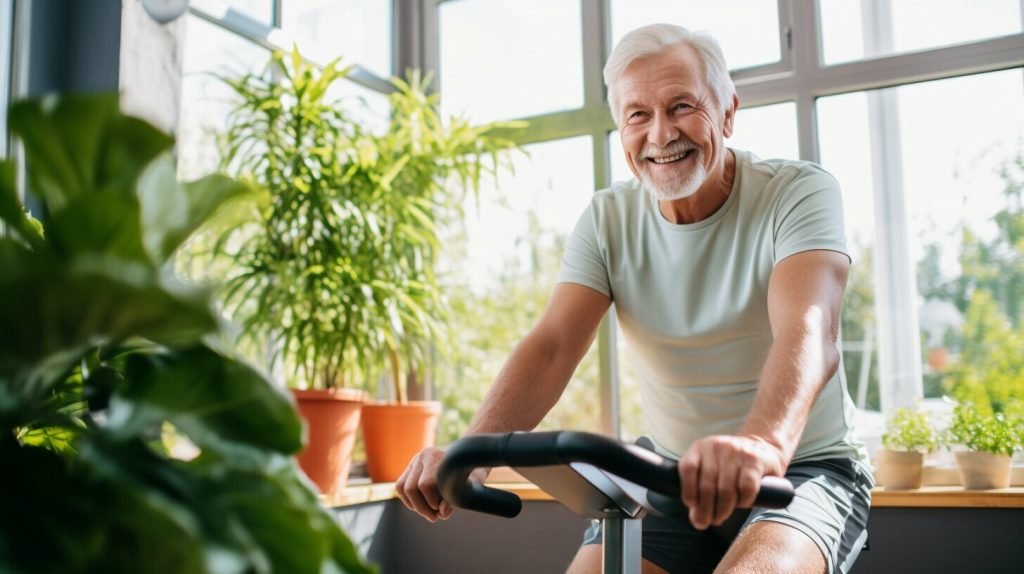
By prioritizing low-impact exercises like swimming, walking, yoga, and strengthening exercises, seniors can reap the full benefits of cardio workouts while minimizing the risk of strain or injury. Remember to start slowly, listen to your body, and consult with a healthcare professional or fitness instructor before starting any new exercise program. With dedication and consistency, you can improve your cardiovascular health, enhance joint mobility, and achieve a healthier, more active lifestyle.
References:
- Mayo Clinic. (2022). Cardio exercise: Top 7 reasons to do low-impact aerobics. Mayo Clinic Healthy Lifestyle. Retrieved from https://www.mayoclinic.org/healthy-lifestyle/fitness/in-depth/aerobic-exercise/art-20045541
- American Heart Association. (n.d.). Low-impact aerobic exercise. American Heart Association. Retrieved from https://www.heart.org/en/healthy-living/fitness/fitness-basics/low-impact-aerobic-exercise
- Harvard Health Publishing. (2019). The real-world benefits of strengthening your muscles. Harvard Health. Retrieved from https://www.health.harvard.edu/healthbeat/the-real-world-benefits-of-strengthening-your-muscles
Swimming: A Gentle Full-Body Workout
Swimming is an exceptional low-impact fitness routine that provides a full-body workout without putting strain on joints, making it an ideal choice for seniors. Not only does it engage all major muscle groups, but it also improves cardiovascular endurance. Whether you prefer leisurely laps or more vigorous water aerobics, swimming offers a multitude of benefits for seniors.
One of the main advantages of swimming is its low-impact nature. The water buoyancy reduces the impact on joints, making it easier for seniors to move and exercise without the risk of injury. Swimming also helps to improve flexibility, as the resistance of the water forces the body to move through a wider range of motion.

In addition to being gentle on the joints, swimming provides a great cardiovascular workout. It increases heart rate and lung capacity, improving overall cardiovascular health. Regular swimming sessions can reduce the risk of heart disease and stroke, as well as help manage conditions such as high blood pressure and diabetes.
| Benefits of Swimming for Seniors: | How to Get Started: |
|---|---|
|
|
Swimming is not only a fun and refreshing way to stay active but also offers numerous health benefits for seniors. So, dive in and make a splash with this low-impact aerobic exercise!
Walking: Easy, Accessible, and Effective
Walking is one of the simplest yet most effective low-impact cardio exercises, offering immense cardiovascular benefits and easy integration into a senior’s daily routine. Whether it’s a leisurely stroll around the neighborhood or a brisk walk in the park, this activity can provide a multitude of health advantages without putting excessive strain on joints.
Not only does walking improve cardiovascular function, but it also helps strengthen muscles, reduce the risk of heart disease, and aid in weight management. Plus, it is an accessible exercise option for seniors of all fitness levels, as it can be easily modified to accommodate individual needs.
| Benefits of Walking for Seniors | How to Incorporate Walking Into Your Routine |
|---|---|
|
|
Remember, consistency is key when it comes to any exercise routine. Aim for at least 30 minutes of brisk walking most days of the week to reap the full benefits. And don’t forget to consult with a healthcare professional before starting any new exercise program, particularly if you have any underlying health conditions.
So, lace up your walking shoes, step outside, and experience the many advantages of this low-impact cardio exercise. Enjoy the fresh air, soak up some vitamin D, and embrace the physical and mental well-being that walking can bring to your life.
Stay motivated with inspirational quotes:
“Walking is the best possible exercise. Habituate yourself to walk very fast.” – Thomas Jefferson
“The best remedy for a short temper is a long walk.” – Jacquelin Schiff
“Walking is man’s best medicine.” – Hippocrates
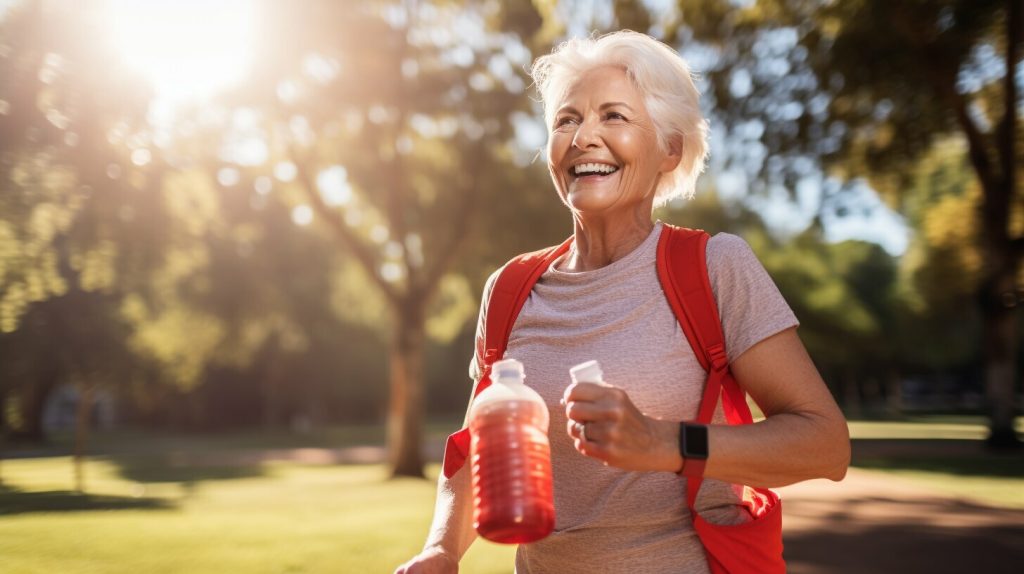
Yoga is a transformative low-impact exercise that not only improves cardiovascular health but also enhances flexibility, strength, and balance, lending a holistic approach to senior fitness. With its gentle movements and focus on breathing, yoga provides seniors with a safe and effective way to engage their bodies while avoiding high-impact activities that can put strain on joints. Whether practiced in a class or at home, yoga offers a multitude of benefits for seniors of all fitness levels.
One of the main advantages of yoga is its ability to improve flexibility. As we age, our muscles and joints tend to lose their range of motion, leading to stiffness and reduced mobility. Yoga’s stretching exercises gently lengthen muscles and promote joint lubrication, helping seniors regain and maintain flexibility. This increased flexibility not only makes daily tasks easier but also reduces the risk of injuries caused by falls or sudden movements.
Another key aspect of yoga is its focus on strength building. Many yoga poses require seniors to support their body weight, which helps develop and maintain muscle tone. Strong muscles are crucial for stability and balance, preventing falls and enhancing overall mobility. Additionally, yoga poses that target the core muscles can improve posture, leading to better spinal alignment and reduced back pain.
Lastly, yoga promotes mental well-being by reducing stress and anxiety. Through the practice of deep breathing and mindfulness, yoga helps calm the mind and improve focus. It also stimulates the secretion of endorphins, the body’s natural “feel-good” hormones, which can boost mood and alleviate symptoms of depression. The combination of physical and mental benefits makes yoga an excellent choice for seniors seeking a low-impact exercise that nurtures the whole self.
Table: Benefits of Yoga for Seniors
| Benefits | Description |
|---|---|
| Improved flexibility | Lengthens muscles and promotes joint lubrication, leading to increased range of motion |
| Enhanced strength | Helps develop and maintain muscle tone, improving stability, and balance |
| Reduced stress and anxiety | Promotes relaxation, calms the mind, and stimulates the release of endorphins |
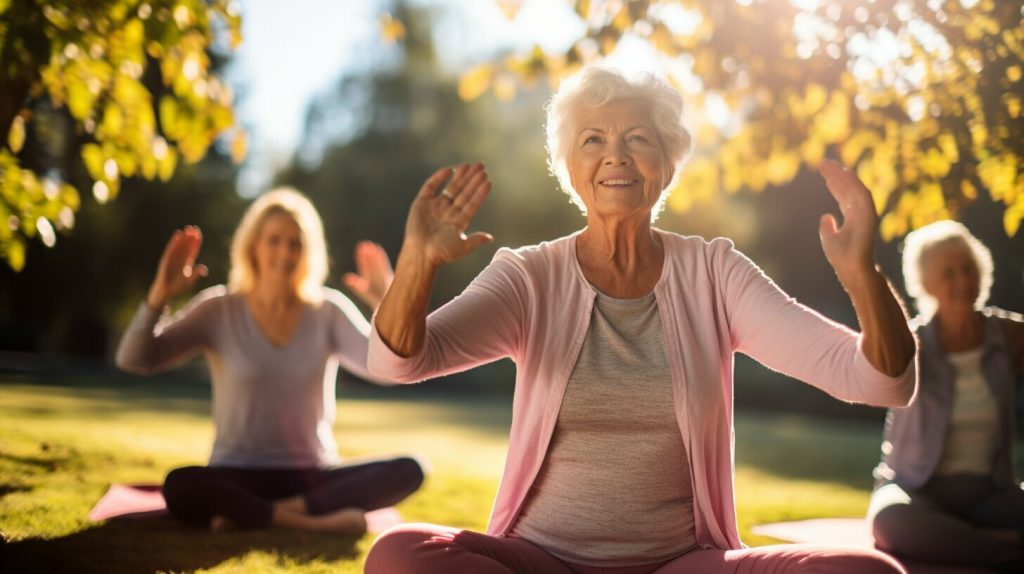
“Yoga is not about touching your toes, it’s about what you learn on the way down.” – Jigar Gor
In conclusion, yoga is a beneficial low-impact exercise for seniors that provides a multitude of physical and mental advantages. By incorporating yoga into their fitness routine, seniors can improve their cardiovascular health, flexibility, strength, and balance. With its focus on mindful movement and breathing, yoga offers a holistic approach to overall well-being. Whether practicing in a class or at home, seniors can enjoy the transformative and rejuvenating effects of yoga, promoting a healthier and more fulfilling life.
Sitting Exercises: Gentle Movements for All Fitness Levels
Sitting exercises provide a low-impact training option for seniors with limited mobility, allowing them to reap the rewards of exercise from the comfort of a chair. These exercises are designed to engage different muscle groups, improve flexibility, and increase circulation. They can be beneficial for seniors recovering from an injury, managing chronic conditions, or simply looking for a gentle form of exercise. Here are some simple sitting exercises that seniors can incorporate into their fitness routine:
1. Ankle Pumps:
Start by sitting upright with your feet flat on the floor. Lift your toes up towards the ceiling while keeping your heels grounded. Then, lower your toes back down. Repeat this movement for 10-15 repetitions to improve ankle flexibility and circulation.
2. Seated Marching:
Sit with your feet flat on the floor. Lift one knee up towards your chest and then lower it back down. Alternate legs and continue marching for 1-2 minutes. This exercise helps improve leg strength and circulation.
3. Seated Side Leg Raises:
While sitting upright, extend one leg out to the side and then bring it back in. Repeat this movement with the other leg. Aim for 10-15 repetitions on each side. This exercise strengthens the hip abductor muscles and improves hip flexibility.
Remember to perform these exercises in a slow and controlled manner, focusing on proper form and breathing. If you experience any pain or discomfort, stop immediately and consult with a healthcare professional. Adding seated exercises to your fitness routine can help improve overall mobility, strength, and balance, making daily activities easier and more enjoyable.
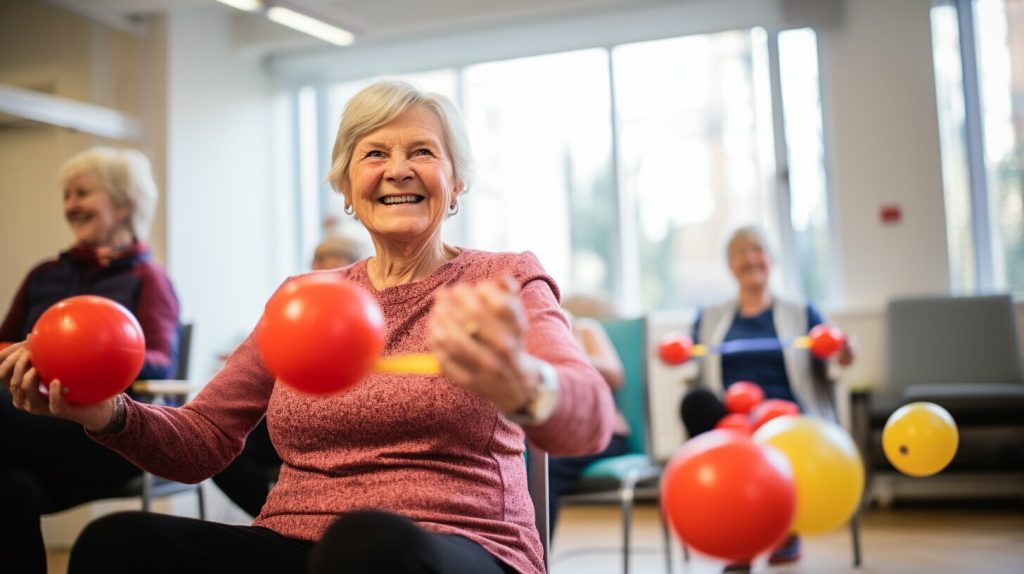
| Benefits | Description |
|---|---|
| Improved Flexibility | Sitting exercises can help increase flexibility in the ankles, knees, hips, and shoulders. |
| Enhanced Circulation | Regular movement of the lower body can improve blood flow and reduce the risk of blood clots. |
| Increased Strength | Performing seated exercises regularly can strengthen the muscles in the legs, core, and upper body. |
| Improved Posture | Sitting with proper alignment during exercises can help improve posture and reduce back pain. |
Strengthening Exercises: Building Up Muscle and Balance
Incorporating low-impact strengthening exercises using weights or resistance bands into a fitness routine can greatly enhance seniors’ muscle strength, balance, and overall cardiovascular fitness levels. Strength training is essential for maintaining and increasing muscle mass, which tends to decline with age. By engaging in regular strengthening exercises, seniors can improve their ability to perform daily activities and reduce the risk of falls or injuries.
One effective low-impact exercise option for seniors is using weights or resistance bands. These tools provide resistance to the muscles, allowing for targeted strength training without putting excessive strain on the joints. Seniors can start with light weights or resistance bands and gradually increase intensity as they become stronger.
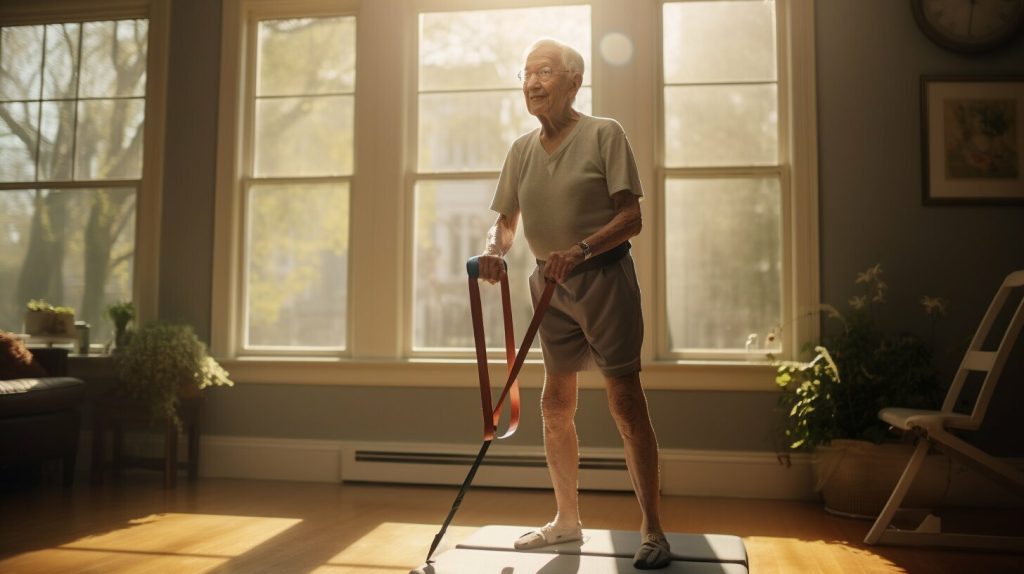
A sample strengthening exercise routine for seniors may include exercises such as bicep curls, tricep extensions, shoulder presses, chest presses, squats, and lunges. It is important to maintain proper form and technique during these exercises to prevent injury.
Remember to always consult with a healthcare professional or a certified fitness trainer before starting any new exercise regimen, especially if you have any underlying health conditions or concerns.
By incorporating low-impact strengthening exercises into their fitness routine, seniors can improve their overall physical health, increase muscle tone and strength, enhance balance and stability, and boost cardiovascular fitness. These exercises, when performed correctly and consistently, can have a significant positive impact on seniors’ overall well-being and quality of life.
| Exercise | Repetitions | Sets |
|---|---|---|
| Bicep curls | 10-15 | 2-3 |
| Tricep extensions | 10-15 | 2-3 |
| Shoulder presses | 10-15 | 2-3 |
| Chest presses | 10-15 | 2-3 |
| Squats | 10-15 | 2-3 |
| Lunges | 10-15 | 2-3 |
Beginner-Friendly Workouts: Low-Intensity Cardio for Seniors
For seniors new to fitness or those with chronic conditions, low-intensity cardio workouts provide a safe and effective starting point for improving cardiovascular health and overall fitness. These workouts are designed to be gentle on the body, reducing the risk of injury and strain while still offering numerous health benefits.
One of the best low-intensity cardio exercises for seniors is walking. It’s an accessible activity that can be done anywhere, and it can be easily adapted to individual fitness levels. Whether it’s a leisurely stroll around the neighborhood or a brisk walk in the park, walking gets the heart pumping and helps to improve cardiovascular function.
If you’re looking for a low-impact workout that engages the entire body, swimming is an excellent choice. It provides a gentle full-body workout while being easy on the joints. Swimming can help improve cardiovascular endurance, muscle strength, and flexibility. Plus, it’s a refreshing way to stay active, especially during the hot summer months.
Yoga is another low-intensity cardio exercise that offers numerous health benefits. It combines gentle movements, stretching, and deep breathing to improve flexibility, balance, and overall well-being. Yoga can be modified to suit any fitness level, making it suitable for seniors of all abilities.
| Exercise | Benefits |
|---|---|
| Walking | Improves cardiovascular health |
| Swimming | Gentle full-body workout, improves muscle strength and flexibility |
| Yoga | Enhances flexibility, balance, and overall well-being |
It’s important to remember that everyone has different fitness levels and abilities. If you’re new to exercise or have any chronic conditions, it’s essential to consult with a healthcare professional before starting any new fitness routine. They can provide personalized recommendations and ensure that you’re engaging in activities that are safe and beneficial for your specific needs.
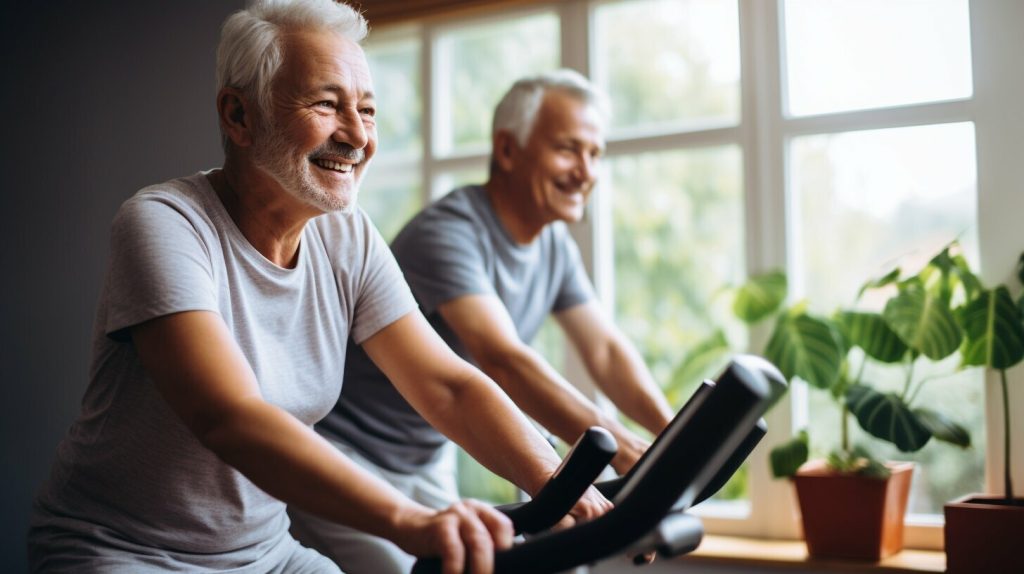
- Start slow and gradually increase the intensity of your workouts.
- Choose activities that you enjoy and that are accessible to you.
- Consider joining a senior fitness class or working with a personal trainer who specializes in working with seniors.
- Listen to your body and make modifications as needed.
- Stay consistent with your workouts, aiming for at least 150 minutes of moderate-intensity aerobic activity per week.
- Remember to warm up and cool down before and after each workout to prevent injury.
Managing Chronic Conditions: Adapted Low-Impact Cardio
Low-impact cardio exercises can be adapted to accommodate seniors with chronic conditions, allowing them to enjoy the benefits of improved cardiovascular health while managing their specific health challenges. These adapted exercises are designed to minimize stress on joints and reduce the risk of injury, making them suitable for seniors with conditions like osteoarthritis or osteoporosis.
One effective low-impact exercise for seniors with chronic conditions is water aerobics. This form of exercise is gentle on the joints while providing resistance to build strength. Water aerobics classes are often available at local pools or fitness centers, and they offer a supportive and safe environment for seniors to stay active.
Another option for seniors with chronic conditions is chair aerobics. This is a seated workout that targets the lower body, upper body, and core muscles. Chair aerobics can be customized to an individual’s fitness level and can be done with the support of a chair for added stability. It’s a great way to improve cardiovascular health while minimizing the impact on joints.
Example Adapted Low-Impact Cardio Workout:
Warm-up: Begin with gentle stretching exercises to warm up the muscles and increase flexibility.
Circuit Training: Alternate between chair aerobics exercises that target different muscle groups, such as leg lifts, arm curls, and seated twists. Perform each exercise for 10-15 repetitions and repeat the circuit 2-3 times.
Cool-down: Finish the workout with light stretching to help relax the muscles and prevent stiffness.
| Exercise | Description |
|---|---|
| Chair Leg Lifts | Sit tall in a chair with feet flat on the floor. Lift one leg straight out in front of you, then lower it back down. Repeat on the other leg. |
| Arm Curls | Hold a pair of light dumbbells or resistance bands in your hands. Sit tall and curl your arms up toward your shoulders, then lower them back down. |
| Seated Twists | Sit tall with your feet flat on the floor. Place your hands behind your head and twist your torso from side to side, engaging your core muscles. |
Remember to listen to your body and modify exercises as needed. It’s always a good idea to consult with a healthcare professional before starting any new exercise program, especially if you have a chronic condition.
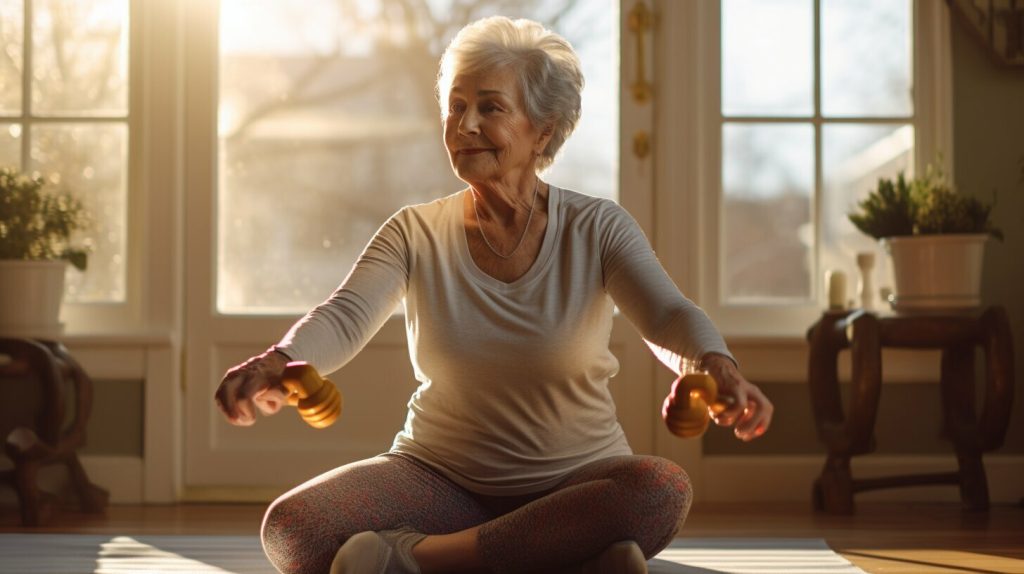
By adapting low-impact cardio exercises, seniors with chronic conditions can maintain and improve their cardiovascular health while managing their specific health challenges. These exercises provide a safe and effective way to stay active and enjoy the numerous benefits of regular physical activity.
Creating a Healthy Fitness Routine: Tips for Seniors
Building a healthy fitness routine centered around low-impact cardio workouts requires careful planning and attention to individual needs, ensuring long-term success in senior fitness. Whether you’re a beginner just starting out or someone with chronic conditions like osteoarthritis or osteoporosis, incorporating low-impact exercises into your daily routine can have numerous benefits for overall health and well-being.
One of the best low-impact workouts for seniors is swimming. Not only does it engage the entire body, but it also provides a gentle full-body workout that is easy on the joints. Additionally, walking is a simple and accessible exercise that can be adapted to different fitness levels. With cardiovascular benefits and the ability to be incorporated into daily routines, walking is an excellent choice for seniors looking to improve their overall fitness.
Yoga is another great option for low-impact cardio exercise. It helps improve flexibility, strength, balance, and cardiovascular health while promoting a sense of relaxation and mindfulness. Yoga can be tailored to suit individual needs and abilities, making it suitable for seniors of all fitness levels.
For seniors with limited mobility, sitting exercises can be an effective way to stay active. These gentle movements and stretches can be done while seated and offer low-impact benefits. Strengthening exercises using weights or resistance bands are also important for building muscle and improving balance, both of which are crucial for overall cardiovascular function in seniors.
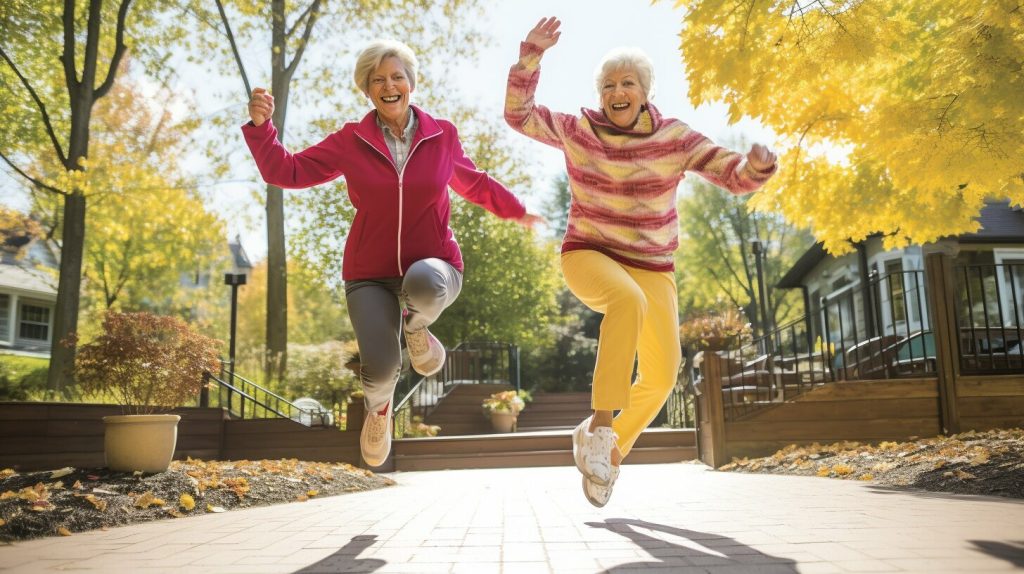
As you create your fitness routine, keep in mind the importance of setting realistic goals and prioritizing consistency. Start slowly and gradually increase the intensity of your workouts to avoid overexertion. It’s also important to listen to your body and seek professional guidance if needed. Remember, low-impact cardio workouts are not only beneficial for physical health but also for mental well-being. So, lace up your shoes, grab your yoga mat, or dive into the pool and enjoy the many benefits of low-impact fitness routines.
| Benefits of Low-Impact Cardio Workouts for Seniors |
|---|
| Reduced risk of heart disease |
| Improved joint health |
| Enhanced flexibility, strength, and balance |
| Manage chronic conditions like osteoarthritis or osteoporosis |
| Reduced risk of injury |
| Accessible for beginners |
Conclusion
Low-impact cardio workouts present an exceptional opportunity for seniors to improve cardiovascular health, joint function, and overall fitness levels, ensuring a vibrant and active lifestyle well into the golden years. These workouts offer numerous benefits without putting excessive strain on joints, making them ideal for seniors of all fitness levels and those with chronic conditions.
By incorporating swimming, walking, yoga, sitting exercises, and strengthening exercises into their fitness routines, seniors can experience improved cardiovascular function, joint health, flexibility, and strength. Embracing low-impact cardio workouts is a step towards ensuring a vibrant and active lifestyle well into the golden years.
Unlock the future of well-being! Delve into our blog for intriguing insights on health and technology. Your journey to a healthier, tech-empowered life begins here.
FAQ
Q: What are low-impact cardio workouts?
A: Low-impact cardio workouts are exercises that provide cardiovascular benefits without putting excessive strain on the joints. These workouts are gentle on the body while still promoting heart health and overall fitness.
Q: Why are low-impact cardio workouts recommended for seniors?
A: Low-impact cardio workouts are recommended for seniors because they offer many health benefits while being easier on the body. These workouts can help reduce the risk of heart disease, aid in the healing and recovery of damaged joints, improve flexibility, strength, balance, and overall cardiovascular function.
Q: What are some of the best low-impact exercises for seniors?
A: Some of the best low-impact exercises for seniors include swimming, walking, yoga, sitting exercises, and strengthening exercises using weights or resistance bands. These exercises cater to a variety of fitness levels and can be modified to suit individual needs and preferences.
Q: How does swimming benefit seniors?
A: Swimming is a gentle full-body workout that engages the entire body while being gentle on joints. It provides a low-impact cardiovascular workout, improves muscle tone, enhances flexibility, and helps with overall cardiovascular health.
Q: Why is walking a great low-impact cardio exercise for seniors?
A: Walking is an easy, accessible, and effective low-impact cardio exercise for seniors. It helps improve cardiovascular health, can be adapted to different fitness levels, and can be easily incorporated into daily routines.
Q: What are the benefits of yoga as a low-impact cardio exercise for seniors?
A: Yoga is an excellent low-impact cardio exercise for seniors as it improves flexibility, strength, and balance. It also promotes cardiovascular health and provides a mindful, calming experience for the mind and body.
Q: What are sitting exercises and why are they beneficial for seniors?
A: Sitting exercises are gentle movements and stretches that can be performed by seniors with limited mobility. These exercises provide low-impact benefits, improve flexibility, promote circulation, and help maintain muscle tone.
Q: How do strengthening exercises benefit seniors?
A: Strengthening exercises using weights or resistance bands can help seniors improve muscle strength, balance, and overall cardiovascular function. These exercises promote healthy aging, reduce the risk of falls, and enhance overall mobility and independence.
Q: What are some beginner-friendly low-impact cardio workouts for seniors?
A: There are several beginner-friendly low-impact cardio workouts for seniors, such as walking, swimming, seated workouts, and gentle yoga. It’s important to start slowly, gradually increase intensity, and listen to your body’s needs and limitations when starting a new exercise routine.
Q: Can low-impact cardio workouts be adapted for seniors with chronic conditions?
A: Yes, low-impact cardio workouts can be adapted for seniors with chronic conditions like osteoarthritis or osteoporosis. It’s important to consult with a healthcare professional or a qualified fitness trainer to ensure exercises are safe and suitable for individual needs.
Q: What are some tips for creating a healthy fitness routine centered around low-impact cardio workouts?
A: Some tips for creating a healthy fitness routine centered around low-impact cardio workouts include setting realistic goals, prioritizing consistency, alternating between different exercises, listening to your body, staying hydrated, and seeking professional guidance when needed.

